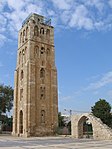Battle of Ramla (1101)
1100s in the Kingdom of Jerusalem1101 in Asia12th century in the Fatimid CaliphateBattles involving the Fatimid CaliphateBattles involving the Kingdom of Jerusalem ... and 2 more
Conflicts in 1101History of Ramla

The First Battle of Ramla (or Ramleh) took place on 7 September 1101 between the Crusader Kingdom of Jerusalem and the Fatimids of Egypt. The town of Ramla lay on the road from Jerusalem to Ascalon, the latter of which was the largest Fatimid fortress in Palestine. From Ascalon the Fatimid vizier, Al-Afdal Shahanshah, launched almost annual attacks into the newly founded Crusader kingdom from 1099 to 1107. It was thrice the case that the two armies met each other at Ramla.
Excerpt from the Wikipedia article Battle of Ramla (1101) (License: CC BY-SA 3.0, Authors, Images).Battle of Ramla (1101)
HaMaapilim,
Geographical coordinates (GPS) Address Nearby Places Show on map
Geographical coordinates (GPS)
| Latitude | Longitude |
|---|---|
| N 31.924794444444 ° | E 34.872708333333 ° |
Address
בי"ס אל עמל
HaMaapilim
7147308
Center District, Israel
Open on Google Maps








